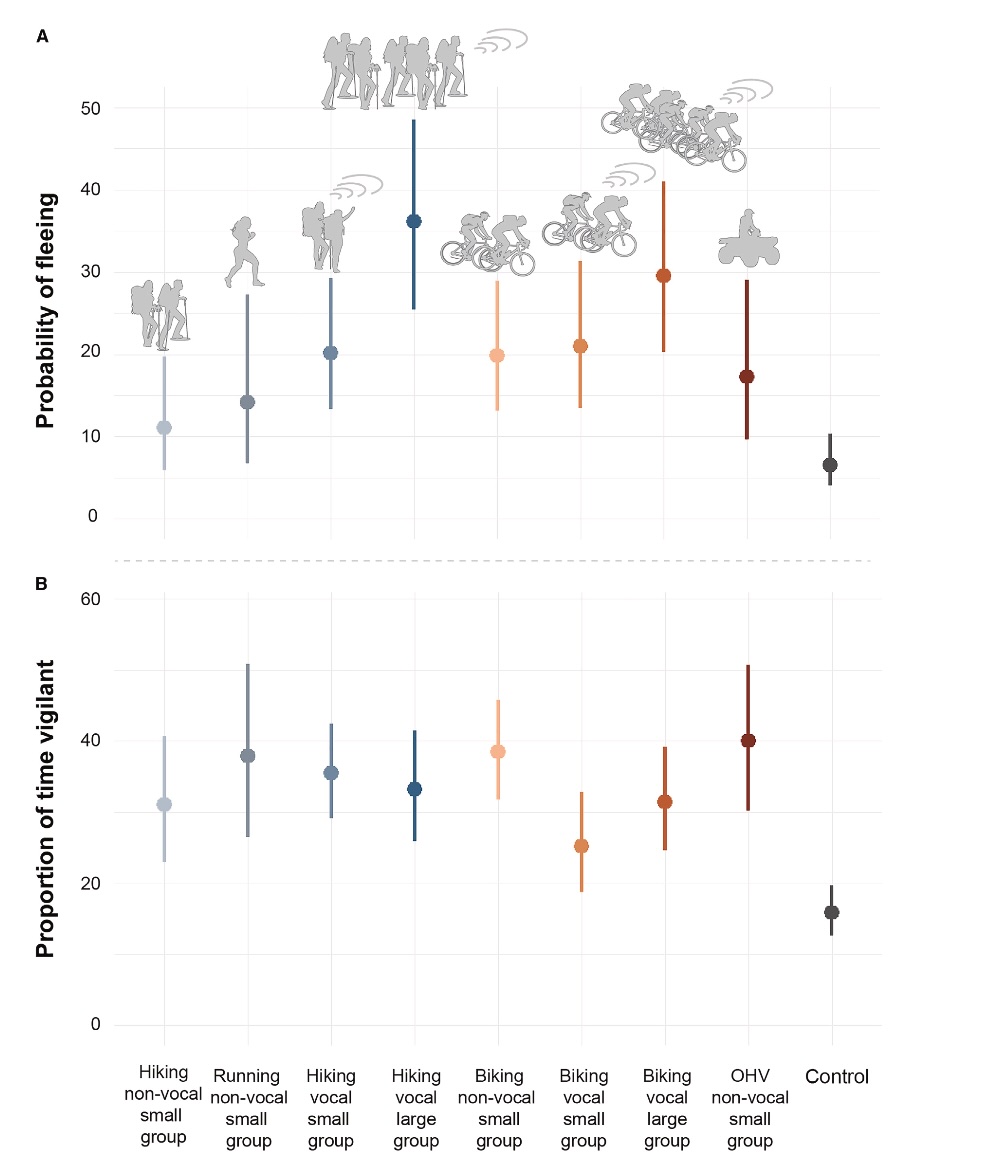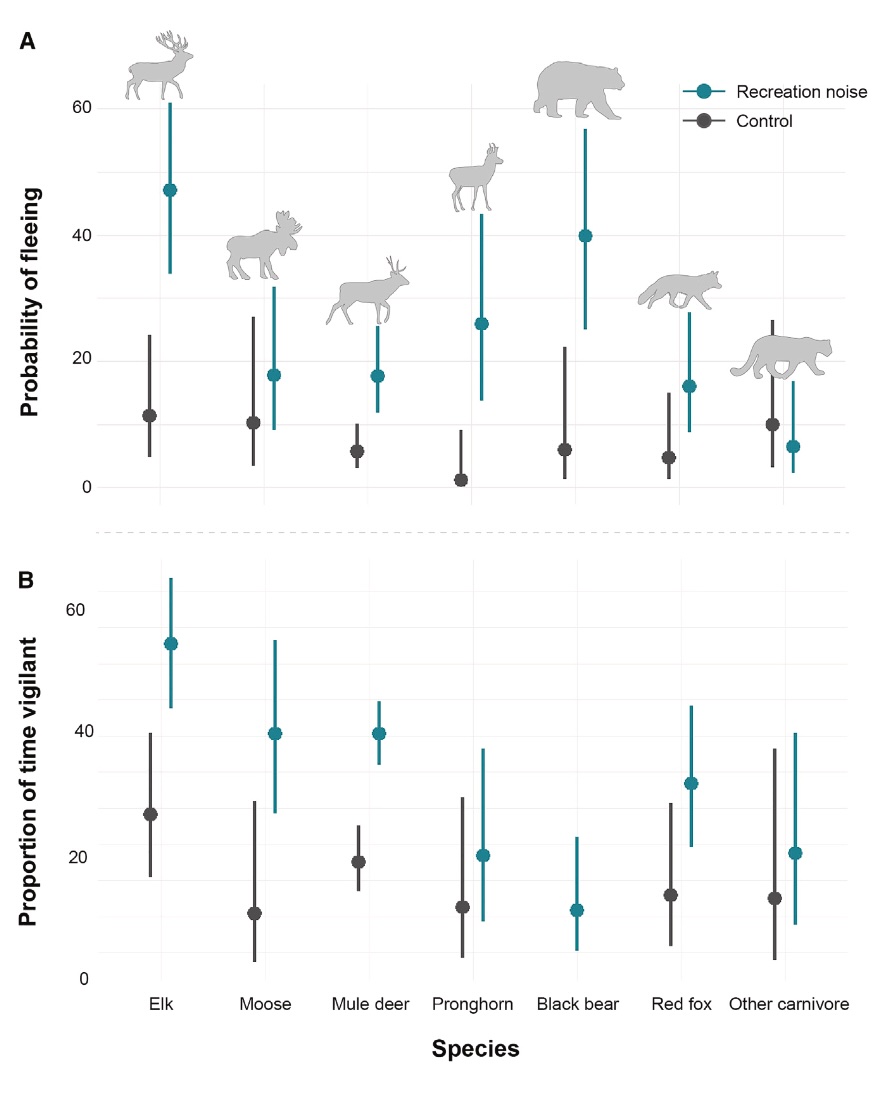Hunters don’t need a team of researchers to tell us that making noise in the woods spooks game — we’ve known that for millennia. What we can’t always tell is how much racket wild critters will tolerate before they run off, or what common outdoor activities pressure them most. Now, some of these questions have been answered thanks to a new study that examined how the noise of increasing outdoor recreation is affecting wildlife.
The study, which was published in the July 2024 issue of Current Biology, examined how game reacts when confronted with the vocal and non-vocal sounds of small and large groups of hikers, trail runners, mountain bikers, and off-road vehicle users. All told, wildlife was 4.7 times more likely to flee from all human noises and those critters remained vigilant three times longer than when no noise was played. What’s more, wildlife abundance at the camera sites was 1.5 times lower the week after recreation noise was played.
To conduct the study, researchers from the U.S. Forest Service and several Western universities deployed trail camera traps and speakers in Wyoming’s Bridger-Teton National Forest. When triggered the speakers played pre-recorded sounds of outdoor users, plus control sounds of non-human activity and no noise at all. They collected and analyzed data from 1,023 audio-trigger events during 4,444 trap nights of mule deer, elk, red fox, black bears, moose, pronghorn, cougars, coyotes, and wolves.
Illustration by Shea Coons / Current Biology
The recordings that scared animals the most were large vocal groups of hikers — animals were eight times as likely to run off when they heard chatty backpackers and reacted similarly to large groups of vocal bikers. While game didn’t flee as often from the sounds of off-road vehicles, animals remained vigilant the longest after hearing four-wheelers nearby compared to any other user group.
Almost all the animals in the study were pressured by any human recreation noise, which included combinations of large and small groups of vocal and non-vocal hikers, bikers, trail runners, and non-vocal OHV users.

Out of the animals studied, elk were the most sensitive to human noise and had a nearly 50 percent probability of fleeing; they also stayed vigilant the longest after running off. Black bears were the second most likely to flee at about 40 percent probability, followed by pronghorn (25 percent). Moose, mule deer, and coyotes all registered roughly the same.
“Though moose and mule deer had lower probabilities of fleeing than elk, black bear, and pronghorn, both have been shown to avoid areas with human recreation in other studies,” the researchers write. “However, moose have also been shown to select for areas of human presence, presumably as a human shield effect from predators, indicating risk-reward tradeoffs and that responses to recreation noise may be situation dependent.”

Large carnivores proved the least sensitive to human noise; cougars did not respond any differently to recordings of human recreation than they did to no noise at all. Researchers noted, however, that there were limitations to conclusions that human recreation noise doesn’t bother the big cats.
“Though carnivores in our study had a weak behavioral response to recreation noise, they may still have been experiencing physiological effects that we were unable to observe. For example, higher stress hormone levels have been found in wolves in response to snowmobile recreation, and though few behavioral changes were observed, acute increases in heart rates were documented in black bears in response to unmanned aerial vehicles. Therefore, lack of an obvious behavioral response may not equate to lack of response, and our results are likely underrepresenting the breadth of effects of recreation noise.”
Of course, the study didn’t examine factors like human scent or the visual presence of recreation, but it wasn’t supposed to; researchers wanted to drill-down specifically into how noise affects wildlife. The upshot, they say, is that even low-levels of recreation noise may cause wildlife to avoid prime habitat — and the forage and cover it affords. All these findings could ultimately lead to different (read: more restrictive) recreation rules.
In grizzly country where people are advised to travel in larger groups and make lots of noise, researchers say recreation managers might consider changing rules to “restrict recreationists to stay on designated trails.”
Read Next: Alaska Officials Kill 81 Bears, 14 Wolves to Help Caribou Calves
The full study isn’t currently available for free and its primary author, Katherine Zeller, wasn’t immediately available for comment. While the study details are interesting, the lessons for hunters who want to be successful are familiar: Hunt solo or in small groups, get away from other people, and keep your mouth shut. Oh, and driving your ATV to your deer stand isn’t as stealthy as you might think.
Read the full article here




